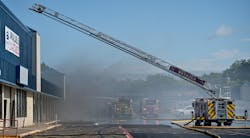Fire Technology: Smoke Containment & Smoke Management Systems
Firefighters learn the basics of building construction during their probationary years, because, as we approach a building that’s on fire, knowing the construction type helps us begin to formulate an attack plan. However, building construction is only a small portion of the larger picture.
When approaching a building that’s on fire, reading the smoke and its various colors, phases and velocity helps to identify the whereabouts of fire and the stage that it’s in. That said, might the smoke be lying to us?
As technology has evolved over the years so has building construction and contents. You likely know that more building materials are synthetic and that they burn hotter and faster than was the case in decades past, but do you know that smoke systems that are within buildings also evolved?
When firefighters rode on the tailboard, if the smoke was coming from the C/D corner, that’s where the fire most likely was. With technology today, smoke might denote where the fire is, but it also could be the exhaust portion of a smoke management system. If there isn’t any smoke visible as we approach the building but silted black windows are visible, there might be a smoke containment system in place, and the fire is waiting to explode.
As you preplan buildings or even just go out in your day-to-day life in your community, look around and notice the subtle differences that are smoke containment and smoke management systems within newer commercial construction.
Smoke containment systems
Smoke containment systems limit the spread of smoke and toxic gases within a building during an incident. These systems include various barriers, such as walls, doors and partitions, that prevent smoke from moving from the area of the fire to other parts of the building. Smoke containment systems play a critical role in protecting both occupants and firefighters, because they help to prevent smoke inhalation and improve visibility within the building.
Some of the most common smoke containment systems are fire-rated walls, smoke curtains, fire doors, smoke dampers and smoke seals.
Fire-rated walls resist the passage of smoke and fire for a specified period of time, typically between 1–4 hours. These walls are constructed with fire-resistant materials, such as concrete or gypsum board, and prevent the spread of fire and smoke to other parts of the building. You see these most commonly in hospitals and schools and often find the rating on the wall in the stairwell.
Smoke curtains are vertical barriers that are made of fire-resistant fabric that can be deployed in the event of a fire. The curtains usually are dropped from the ceiling and can be activated automatically or manually to close off openings in walls or ceilings to prevent the spread of smoke. These can be found in larger buildings, such as gymnasiums and other open plan commercial facilities, where oxygen can fuel the fire, which enables the fire to travel faster than it does where there aren’t any barriers.
Like fire walls, fire doors also stop the passage of smoke and fire for a specified period of time and are constructed with fire-resistant materials. These doors are equipped with seals that expand when they are exposed to heat. Fire doors commonly are found in schools and hospitals. Similar to fire curtains, they can be engaged manually or automatically.
Smoke dampers aren’t as easy to identify as fire walls, smoke curtains and fire doors are. Smoke dampers are installed in the ductwork of heating, ventilation and air conditioning (HVAC) systems to prevent the spread of smoke through the systems. These devices automatically close when smoke is detected, to prevent smoke from spreading throughout the building.
A smoke seal is a gasket or strip of material that’s installed around door frames and other openings in walls or ceilings. Smoke seals expand when they are exposed to heat, which helps to create a barrier that prevents smoke from spreading to other parts of the building. Often, smoke seals are used in conjunction with a fire door, to expand during the event of an emergency.
In addition to helping to control the spread of smoke, smoke containment systems also can help to contain the fire itself, because they limit the amount of oxygen that’s available to the fire. This can reduce the risk of property damage and might help to prevent the fire from spreading to neighboring buildings or structures.
Smoke management systems
Smoke management is a strategy of attempting to control the movement of smoke within a building. This is accomplished using ventilation systems, such as fans and vents, which direct smoke away from occupied areas and out of the building. Smoke management is important, because it can help to reduce the concentration of toxic gases and particles in the air, which makes it safer for firefighters to operate within the fire building.
Some common smoke management systems that can be found in buildings are smoke exhaust systems, pressurized rooms and systems, and sprinkler systems.
Exhaust systems help to clear the building of smoke in the instance of an emergency. They use a combination of fans and ductwork. However, this can lead firefighters to believe that the fire is in one location when it might be in another. These systems often are used in large open space areas.
Pressurizing rooms by the use of fans and fire-rated doors and seals essentially “containerizes” each location of a building, which helps to stop the free movement of smoke. This type of smoke management is found most commonly in stairwells of larger buildings. The stairwells are pressurized to prevent smoke from entering, which can be critical for safe egress during a fire incident. These systems’ fans create higher-pressure zones, which limits and attempts to prevent smoke from entering when doors are open or closed.
Sprinkler systems are one of the most common additions to commercial buildings. They can manage smoke by suppressing it upon activation of the sprinkler heads. Once a sprinkler is activated, usually by immense amounts of heat, the water that’s dispersed helps to push the smoke and contain it to a point to help to allow for safe exit of the building for occupants. Also, because sprinklers can put out fire early, they limit the total amount of smoke that’s produced by a fire, which subsequently makes the fire easier to manage.
By attempting to contain the smoke in a building fire, smoke management systems give occupants a better chance of evacuation during an emergency. They also help by containing toxic gases that could further contribute to the growth of the fire. Containment of toxic gases provides firefighters with more time to help.
Multipurpose results
Smoke containment and smoke management help to reduce the risk of smoke-related injuries and fatalities and make it easier for firefighters to locate and rescue individuals who might be trapped within a building. Effective smoke containment and smoke management also can help to reduce the amount of property damage that’s caused by smoke and fire and, ultimately, increase the rate of survivability and exit during a fire.
About the Author

Justin Rodino
Justin Rodino is a fourth-generation firefighter who has more than 20 years in the service. He began his career at Wabash Township, IN, Fire while he attended Purdue University and then served on Snoqualmie Pass Fire & Rescue as a firefighter, ski patroller and EMT. Currently, Rodino is a career lieutenant at Carroll County, GA, Fire and Rescue, which is located on the outskirts of Atlanta on busy Interstate 20. He is a hazmat technician, teaches, writes and assists with the PIO duties. On his off days, Rodino is a computer engineer, helping to write software for the fire service.
